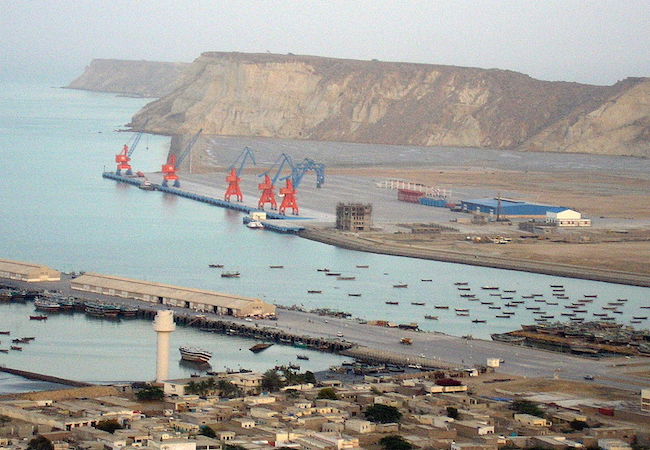
By Shahzadi Tooba Hussain Syed
Gwadar port is located at the mouth of gulf and opposite strategic choke points of Strait of Hormuz and Gulf of Oman. The Gwadar port is seen as central to the China-Pakistan Economic Corridor (CPEC) that will connect the impoverished western region with Central Asia and the Middle East through a network of rail and road links passing through Pakistan. The port is visualized to become a regional hub serving commercial traffic of Middle East and Gulf countries. The port of Gwadar may attract transit and trans-shipment trade from over twenty countries including Sri Lanka, Bangladesh, Oman, UAE, Saudi Arabia, Qatar, Iraq and Iran. These countries may open their warehouses in Gwadar for export of goods and storing of imported goods for later shipment to their countries.
On the other hand, the strategic Chabahar port in southeastern Iran is central to New Delhi’s efforts to circumvent Pakistan and open up a route to landlocked Afghanistan where it has developed close security relations and economic interests. It’s a symbol of Indo-Iran economic and strategic cooperation and will provide India access to Afghanistan, bypassing Pakistan. Chabahar is also linked to India’s natural gas imports from Iran, as the port would also serve as the point of origin for the proposed Iran-Oman-India pipeline.
India’s strategic thinkers also view the port as a strategic counterweight to China’s pursuit of a port in Pakistan’s Gwadar. Its India’s ultimate desire to connect Chabahar with Central Asian countries through roads and a network of railway system to bypass Pakistan, and to reduce the dependency of Central Asian countries on the port of Gwader. It is the part of the Indian plan to develop transportation infrastructure in eastern Iran, in order to reduce the growing influence of Gwader port. How India sees the Gawadar Port. According to the recent report of Delhi Institute for Defence Studies and Analysis, that Gwadar will provide Beijing with a facility to monitor Indian naval activity in the Persian Gulf and Arabian Sea, as well as any future maritime cooperation between India and Iran. Gwadar port being so close to the Straits of Hormuz also has negative implications for India’s commercial interest, as in 2008 then Indian chief of naval staff Sureesh Mehta said that Gawader could be used by Pakistan to “take control over the world’s energy juggler.” At the same time Iranian officials apprehend that Gwadar would be used by the United States as a base to monitor activities inside Iran.
China’s interests at Gwadar are very clear; China is looking for monitoring of its Gulf oil supply route as well as an opening for import/ export trade from its Muslim-majority Xinjiang Autonomous Region.
However, as a part of Pakistan’s overall strategy for enhancing its influence in Central Asia and beyond the deep water port, Pakistan can provide Gwadar port to landlocked CARs. Gwadar can be a potential trade route for the CARs. The trade route can bring a lot of investment to Pakistan. So far the newborn states are relying more upon Pakistan for trade and commercial purposes.
This port would have tremendous economic impetus to Pakistan for several reasons. It is located about 250 miles from the Straits of Hormuz through which some (40 percent of the world’s oil supplies Region). Second, the strategic location of the port makes it as an important regional shipping hub, providing the landlocked Central Asian republics, Afghanistan, and the Chinese Xingjian region an access to the Arabian Sea and third it will reduce the distances of 500 km between Pakistan and Central Asia. And more significantly, it will facilitate the transfer of Central Asia’s vast energy resources to world markets through Pakistan with significant profits in transit fees.

Chabahar would provide India an access to Afghanistan via Indian Ocean. India, Iran and Afghanistan have signed an agreement to give Indian goods, heading for Central Asia and Afghanistan, preferential treatment and tariff reductions at Chabahar. India also assisted Iran to construct railway spurs linking its rail network to that of Central Asia, the process considerably reduces Pakistan’s strategic leverage over these landlocked states thus providing them alternative corridors to the sea. New Delhi has undertaken vital role in the development of Iranian port facilities along with the construction of road and rail links. Indian engineers have contributed immensely towards the up gradation and development of the Iranian port of Chahbahar. New Delhi and Tehran have agreed to ‘join hands’ in the reconstruction of Afghanistan and to support the development of alternative access routes to that country (bypassing Pakistan) via Iran’s Chahbahar port.
Moreover, India is developing Chahbahar and is laying railway tracks to connect it to Zaranj in Afghanistan, proclaiming that this would be a commercial port. In addition, India has constructed the 218 km long Zaranj-Delaram highway that now links Afghanistan to the Iranian port of Chahbahar as part of the Afghan circular road that connects Herat and Kabul via Mazar-e-Sharif in the north and Kandhar in the south- thereby providing easier access to Afghanistan and possibly even further, to Central Asia via Iran. There is also another project that involves linking Chahbahar to the Iranian rail network that is also well connected to Central Asia and Europe. Islamabad-Tehran’s conflicting interests over Afghanistan have played a pivotal role in the formation of their Indo-Iranian Nexus. Moreover, India’s attempt to build roads linking Afghanistan and Central Asia and Iranian ports as a response to China’s building up of a deep-water port in Gwadar as a gateway to global markets for Central Asian resources.
Competition aside, a proposal has been made by Iran to increase their bilateral cooperation. The current volume of bilateral trade between Iran-Pakistan is about $230 million per annum, but the two countries are eyeing to increase it to $5 billion over the next five years. Pakistan’s stance on Chahbahar port is that Pakistan expected Chabahar and Gwadar ports to complement each other instead of being rivals.
Thus cooperation is a better idea instead of taking competitive positions and creating hurdles for development of each other’s ports. Because both parties’ optimal benefits from this opportunity is conditional to mutual trust and cooperation. Pakistan and Iran must not let any third power to take opportunity of getting all the benefit.




